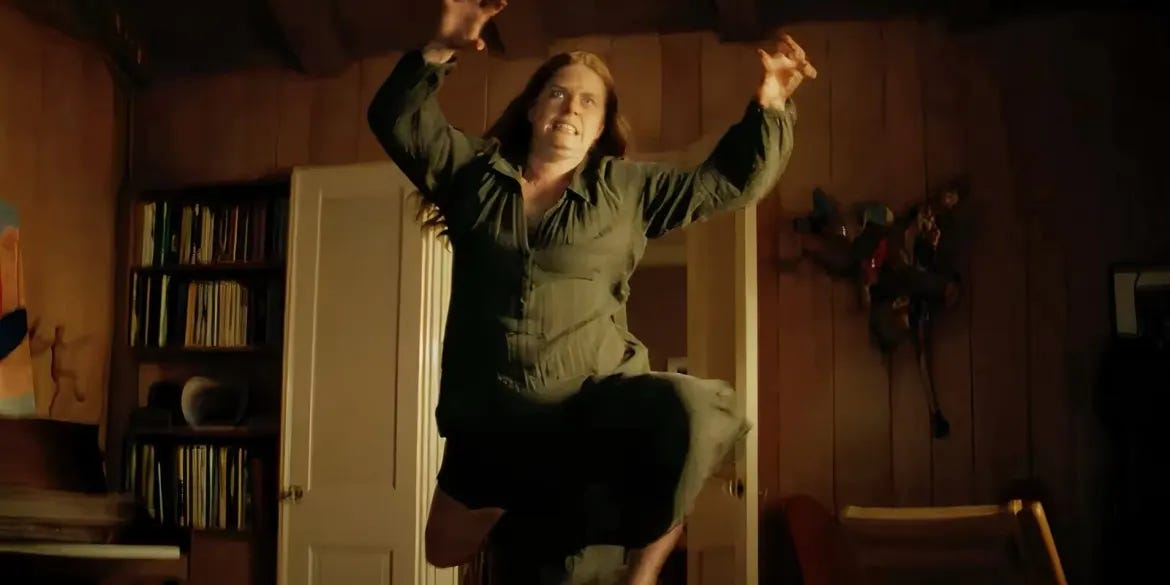Nightbitch And the Mess of Female Creation
Motherhood and art circle each other and growl.
Marielle Heller’s Nightbitch, like it’s titular character, is an uncomfortable hybrid—part horror film, part domestic suburban melodrama. The pieces fit together oddly, which is definitely the point in a movie about enforced domesticity and volcanic creativity, and the woman whimpering, and occasionally howling, between them.
That woman is Mother (Amy Adams), an artist who’s given up her promising career to watch her two-year old child (Arleigh and Emmett Snowden) while her Husband (Scoot McNairy) travels extensively for his high-powered (but never identified) job.
Mother loves her kid, but also resents him and the bleak round of preparing food, changing diapers, mommy yoga, and endless bedtime negotiations—all of which have stripped her of her career, not to mention her personality. “My brain just doesn’t function the way it did before the baby and I’m dumb now,” Adams gushes with manic cheer in a white-knuckle opening monologue where she appears to be on the verge of breaking into tears and/or throttling the artworld friend she happened to bump into in the grocery aisle.
All that anger and thwarted energy comes out unexpectedly in weird hairs on her chin and a cyst on her back which releases something very like a tail. Her devolution nods to body horror, but then grabs that genre in its teeth and shakes it, as Mother’s hallucinatory canine episodes put her in touch with her own misery in a way that allows her to tell her husband he’s got to get his shit together, take the kid, and leave mom with time to paint.
Some critics have been put off by the tonal shifts, and by the Friedan-esque retro suburban gender politics. And it’s true that the movie is both gratingly normal and gratingly off in a mundane, irritating way that lacks the polish, beauty, or dream logic of a David Lynch effort. The movie is technically magical realist, but it doesn’t feel very magical, because hanging out with a child 24/7 and cleaning paint off the walls just isn’t magical—at least, not in that way.
The atmospheric inconsistency does manage to capture something that I, at least, wincingly recognize from doing time as the main parental caretaker of an infant with colic, where everything turns into a sleep-deprived hallucinatory trek from one befouled surface to another, interspersed with rather desperate loneliness, intermittent, panicked efforts to find the lost Thomas the Tank Engine and occasional flashes of overwhelming transcendent joy.
For women, domesticity is an exponentially more charged edifice, with much heavier bars. In the Mother’s case, those bars separate her form her creativity—or more precisely separate her creativity into two mutually snarling antagonists. As a mother, she’s supposed to create with her body, growing another creature naturally with the animal accoutrement of blood and viscera. But how can that fit with being an artist, who is supposed to create with intention and control in the head? How do you reconcile a room of one’s own with a womb of one’s own?
This is a difficulty, or a challenge, that has confronted many women artists. It served as an inspiration, for example, for Carolee Schneemann and feminist performance artists who used nudity and a range of spurting fluids to wrap art in the wet folds of flesh and flesh in the wet folds of art. In Rachel Yoder’s novel which is the inspiration for the film, the Mother works in that tradition, creating a climactic ritual performance that builds creation literally from her body, birthing and being birthed by art.
The film is not quite willing to go there, unfortunately. Mother’s final gallery show features significantly less spew-some painting and sculpture, suggesting she’s moved past her dog self rather than ingesting it.
That’s a disappointing choice, in part because you just don’t generally see feminist performance art filmed as part of a major Hollywood star vehicle, and in part because it makes the ending reconciliation feel too pat to be entirely satisfying.
On the other paw, there’s a nice nod to sisterhood in the glimpses we see of the paintings; most of the them are portraits of Mother’s friends from library sing along and Baby yoga. It’s a nod perhaps to the fact that this is a movie by a woman creator adapting the work of a woman creator about woman creating. Painting, sculpture, movies, books, babies—the things that come out of women are sometimes weird, sometimes disappointing, sometimes annoying, sometimes miraculous. Nightbitch is an imperfect mess, but so, the film suggests, is motherhood.



“The movie is technically magical realist, but it doesn’t feel very magical, because hanging out with a child 24/7 and cleaning paint off the walls just isn’t magical—at least, not in that way.”
This tees up the question of how any movie could show two such clashing reality experiences together and make coherent story. Whew!
All hail to mothers.
The book relies so much on Mother’s inner dialogue to describe crushing fatigue, her needing and wanting help but not thinking to ask her husband, then when it turned out all she needed to do was ask, there’s a brilliant passage where she isn’t mad at her husband but definitely irritated in his general direction. That’s an incredible amount of plot and conflict happening silently. She could narrate her thoughts, but then there’s the risk audience rejects that as condescending or, like in Lynch’s “Dune”, finding it both condescending and still being baffled as to what’s going on.